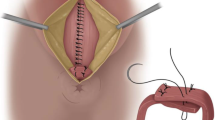Purpose
This study was designed to compare two different types of anal retractors (Parks vs. Scott) with regard to their impact on fecal continence after fistula repair. METHODS: Between November 2000 and November 2001, 30 patients were randomized into two groups. In Group A (n = 15), a Parks retractor was used during fistula repair, whereas in Group B (n = 15), the repair was performed with a Scott retractor. Before and three months after surgery, maximum anal resting pressure and maximum anal squeeze pressure were recorded. In addition, continence status was evaluated using both the Rockwood Fecal Incontinence Severity Index and the scoring system according to Parks. RESULTS: In Group A, the median anal resting pressure dropped from 76 mmHg to 42 mmHg. In Group B, no significant difference was observed between the preoperative and postoperative anal resting pressure. The difference in the changes from baseline between the two groups was statistically significant (P = 0.035). No significant changes in anal squeeze pressure were observed. In Group A, the median Rockwood fecal incontinence score increased from 0 to 12. In Group B, the median Rockwood fecal incontinence score did not change after the operation. The difference between the two groups was statistically significant (P = 0.038). CONCLUSIONS: The use of a Parks retractor during perianal fistula repair has a deteriorating effect on fecal continence, probably because of damage to the internal anal sphincter. Because this side effect was not observed after the use of a Scott retractor, we advocate the use of this retractor during all fistula repairs.
Similar content being viewed by others
References
Lunniss PJ, Kamm MA. Factors affecting continence after surgery for anal fistula. Br J Surg 1994;81:1382–5.
van Tets WF, Kuijpers HC. Continence disorders after anal fistulotomy. Dis Colon Rectum 1994;37:1194–7.
Wedell J, Meierzu Eissen P, Banzhaf G, Kleine L. Sliding flap advancement for the treatment of high level fistulae. Br J Surg 1987;74:390-l.
Shemesh El, Kodner IJ, Fry RD, Neufeld DM. Endorectal sliding flap repair of complicated anterior anoperineal fistulas. Dis Colon Rectum 1988;31:22–4.
Willis S, Rau M. Chirurgische thérapie hoher anorectaler und rectovaginaler fisteln mittels transanaler endorectaler verschliebelappenplastik. Chirurg 2000;71:836–40.
Aguilar PS, Plasencia G, Hardy TG Jr, Hartman RF, Stewart WR. Mucosal advancement in the treatment of anal fistula. Dis Colon Rectum 1985;28:496–8.
Ortiz H, Marzo J. Endorectal flap advancement repair and fistulectomy for high transsphincteric and supras-phincteric fistulas. Br J Surg 2000;87:1680–3.
Golub RW, Wise WE, Kerner BA,et al. Endorectal mucosal advancement flap: the preferred method for complex cryptoglandular fistula in ano. J Gastrointest Surg 1997;1:487–91.
Schouten WR, Zimmerman DD, Briel JW. Transanal advancement flap repair of transsphincteric fistulas. Dis Colon Rectum 1999;42:l4l9–23.
Gustafsson U-M, Graf W. Excision of anal fistula with closure of the internal opening: functional and manometric results. Dis Colon Rectum 2002;45:l672–8.
van Tets WF, Kuijpers JH, Tran K, Mollen R, van Goor H. Influence of Parks’ anal retractor on anal sphincter pressures. Dis Colon Rectum 1997;40:1042–5.
Cintron JR, Park JJ, Orsay CP,et al. Repair of fistulas-in-ano using fibrin adhesive: long-term follow-up. Dis Colon Rectum 2000;43:944–50.
Rockwood TH, Church JM, Fleshman JW,et al. Patient and surgeon ranking of the severity of symptoms associated with fecal incontinence: the fecal incontinence severity index. Dis Colon Rectum 1999;42:1525–32.
Aguilar PS. Invited editorial. Dis Colon Rectum 1999;42:1422–3.
Li L, Zhang J-Z, Lu G-W, He G-R, Lui X-H. Damaging effects of anal stretching on the external anal sphincter. Dis Colon Rectum 1996;39:1249–54.
Author information
Authors and Affiliations
Additional information
Read at the meeting of the Netherlands Association of Surgery (NWH), Scheveningen, the Netherlands, May 30 to 31, 2002.
About this article
Cite this article
Zimmerman, D.D.E., Gosselink, M.P., Hop, W.C.J. et al. Impact of two different types of anal retractor on fecal continence after fistula repair. Dis Colon Rectum 46, 1674–1679 (2003). https://doi.org/10.1007/BF02660774
Issue Date:
DOI: https://doi.org/10.1007/BF02660774




